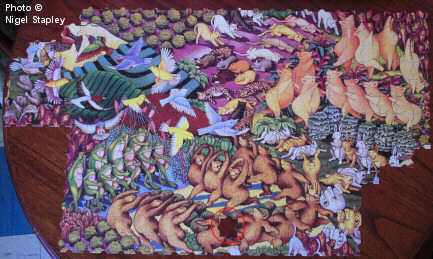 This Is Not A
BLOG!
This Is Not A
BLOG!
Date: 18/09/16
"The Moving Puzzle Puzzes..."
I finally took my courage in both hands and set to work on the picture puzzle which Carl had brought me the week before.
As I indicated last time, this was not a standard jigsaw, but something called a 'Moving Puzzle'. This meant that a section of it could - should you be so impetuous - appear either jutting out of the upper left-hand side of the picture or jutting out of the top right. Clever, huh?
Another thing which makes it different to the norm is that the pieces don't interlock in the same way; or in any real way, for that matter. Each tile has two 'bumps' and two 'notches' on it, and said bumps and notches merely fit where they touch. This, as I was to discover, meant that a steady hand was as essential to its completion as a sharp eye, as to accidentally nudge one piece made all the adjacent pieces come adrift from one another.
The picture itself, as will be seen below, is quite a scary one to start with. It's entitled Garden Hideaway, but as it is clearly composed of a vision which is one part Tenniel, one part Salvador Dalí and three parts cheese nightmare, one is drawn to the conclusion that the only things likely to be hidden away in that particular garden are the (uncredited, probably due to issues of patient confidentiality) artist's stash of skunk or psilocybin.
The one method I was not going to able to deploy on this puzzle was to find the edge pieces first, all tiles being exactly the same shape. Instead, I thought that it would be a good idea to collect together pieces from the same general area in a number of piles and work from there. So, I picked out all of those which I could detect from the 'pig' area and put them aside. I then tried the same for the 'dancing bear' bit and - with less success - for the frog, bird, rabbit and cat zones. I was left with two problems from this: one was that there were tiles which couldn't be readily identified in and of themselves with any specific part of the scene; and the other was that, given the limitations of space (and I was getting quite hopeful that the puzzle would prove to be too large for the table, giving me the required excuse to abandon it), I was left with insufficient room in which to start building the puzzle itself.
I went away from it for a day or two because it was - as my colleague Sara would put it - 'doing me cake in'. When I returned, I decided on a less general strategy. Looking at the picture, I determined that the frogs - all of whom were sitting down and facing the same way (unlike the bears and pigs, who seemed to be auditioning for Strictly Non-Entities) - would be the best starting point. So I extricated from the box all the parts which I could readily identify as amphibian, and started to build from that corner.
Having gone as far as I could with the frogs (and, in the matter of frogs, perhaps one may determine whether someone is highbrow or lowbrow as to whether they have in their minds at the time passages from Aristophanes or that abominable song by Paul McCartney), I then turned (and 'turned' may be the word, given the capers they were cutting) to the bears. It wasn't just because they covered a larger area that this took a lot longer; it was trying to make out which way up any of them were which took time.
It was only at this point, with my frustration growing to such an extent that I seriously considered giving up on the whole thing, that I tumbled to two obvious facts: firstly, as I said above, that all the pieces were the same shape; and secondly (and crucially) that they all lined up in the same orientation, namely that the two notches were always to be on the bottom and the right, and the two bumps on the top and the left. This at least narrowed down the available options. The bears' section was dealt with (except in one respect, as you'll see later), and I moved on to the birds (trickier, because they encroached far more into other parts of the picture), followed by the rabbits (some of whom were sufficiently scary-looking as to induce suspicions of carnivorous tendencies on their part; or of the rabbits who feature briefly in the mid-to-late chapters of Edmund Cooper's gloriously bleak 1970 satire Kronk), then the cats and finally the pigs. These last proved to be a handful because - as with the Mount Titlis forest and the yachting scene in Summersports, there were an awful lot of pieces of very similar colour. That I had trouble getting the right piece of future pork in the right place (for the same reason of confusing orientation as with the bears, only more so) gave a whole new meaning to the phrase 'pig's arse'.
Just before lunch today, I finally slotted in the final piece and the job was done...

...except for the fact that one tile - a part of the dancing bears - was clearly missing (as indicated by the red circle). Whilst frustrating in a minor sense, I don't intend letting the Zeigarnik Effect come into play over it. I just sent a satirical and sardonic e-mail to Carl to advise him that his attempts to drive me out of my tree had almost entirely failed.
My next challenge sees me back to a standard jigsaw: a 700-piece number related to the work of Hans Christian Andersen.
File under: Me

 This Is Not A
BLOG!
This Is Not A
BLOG!











